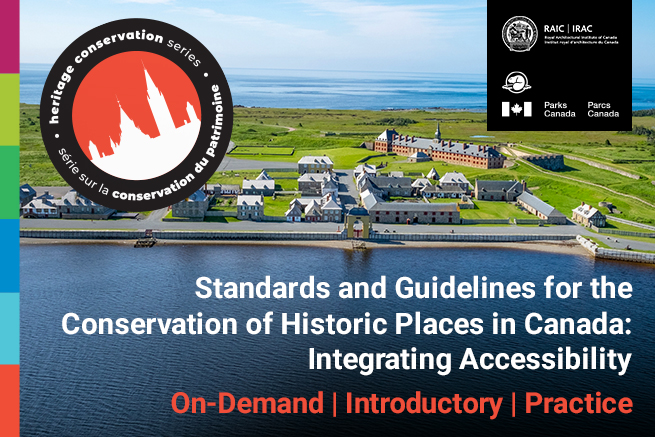
FOR IMMEDIATE RELEASE
OTTAWA, September 26, 2024 – The RAIC is proud to partner with Parks Canada to bring an important educational offering in our Heritage Conservation Series to the architecture community. We are pleased to offer this new, on-demand course–available in English and French–and to make registration available free for anyone.
Launch Date: September 26, 2024
Topics: Heritage and Conservation / Accessibility
Length: 3 hours
Level: Introductory
What’s Included: 3-part online, on-demand course, quizzes, and a certificate of completion
Language: Available in English and French
Pre-requisite: The following course is recommended in advance of this new module Introduction to the Standards and Guidelines for the Conservation of Historic Places in Canada
It is recommended that participants have a basic working knowledge of:
-
What is meant by a historic place, heritage value, and where to find heritage value statements;
-
Heritage conservation best practices in Canada as observed through heritage conservation project implementation in Canada;
-
Standards and Guidelines for the Conservation of Historic Places in Canada (2010), how to use the document, and knowledge of terms such as “the conservation decision-making process,” “intervention,” “rehabilitation,” and “character-defining element” as they are used in the document; and,
-
How design processes evolve and change in typical design and construction projects.
Learning Objectives
At the conclusion of this course, participants will be able to explain:
-
Key concepts when considering an accessibility project at a historic place;
-
Which conservation treatment, standards and guidelines support accessibility interventions at a historic place;
-
How the early integration of heritage conservation professionals in the conservation decision-making process supports the discovery of options to meet functional requirements as well as mitigate loss of heritage value; and,
-
The conservation decision-making process, in applying the Standards and Guidelines in an accessibility project through a case study of a historic place.
About the Standards and Guidelines
To provide the Canadian public with a comprehensive tool to guide heritage conservation practice, the Standards and Guidelines for the Conservation of Historic Places in Canada was created in 2003. The result of a major collaborative effort among federal, provincial, territorial and municipal governments, heritage conservation professionals, and scores of individual Canadians, this detailed publication was the first of its kind in Canada. Developed for a broad range of users—including architects, building owners, property managers and landscape experts—the Standards and Guidelines serves as a reliable benchmark for heritage conservation practice in Canada and is an indispensable reference work for professionals in that field. The Standards and Guidelines were adopted by federal, and many provincial, territorial, and municipal jurisdictions as ' best-in-class’ guidance for managing Canadian conservation projects and at historic places. Since then, there has been a sustained and increasing interest in the document.
In 2010, the Standards and Guidelines was updated with a second edition.
About RAIC
In 2017, the RAIC surveyed its membership, seeking to understand the areas of professional architectural practice for which members wanted more educational tools and training opportunities. Further training opportunities in heritage conservation and adaptive reuse were among the most requested topics.
At that point, the RAIC contacted Parks Canada, and discussions started about a collaboration to expand awareness, understanding, and use of the Standards and Guidelines. The goal of this newest collaboration to develop a second module on the topic of accessibility is to continue to expand awareness, understanding and use of the Standards and Guidelines for the Conservation of Historic Places in Canada.
About Parks Canada
Parks Canada’s mandate is to protect and present nationally significant examples of Canada’s natural and cultural heritage – and to foster public understanding, appreciation, and enjoyment in ways that ensure their ecological and commemorative integrity for present and future generations.
In collaboration with provincial and territorial governments, Parks Canada developed the Standards and Guidelines for the Conservation of Historic Places in Canada, as the benchmark guide for the conservation of historic places. Parks Canada is pleased to work with the Royal Architectural Institute of Canada to expand awareness of the Standards and Guidelines, in order to help promote good heritage conservation practice in Canada.



